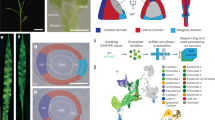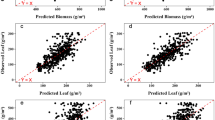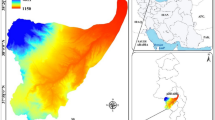Summary
It was suggested that the leaf mark polymorphism of Trifolium repens might be important in visual selection of diet by sheep. Sheep with rumen fistulae were allowed to graze in restricted areas of permanent grassland and the morph frequency in the rumen was compared with that on offer in the pasture. There was clear preference by the sheep for unmarked leaves and some evidence that suggests apostatic selection between the various forms of mark.
Similar content being viewed by others
Article PDF
References
Allen, J A, and Clarke, B. 1968. Evidence for apostatic selection by wild passerines. Nature, 220, 501–502.
Angseesing, J P A, and Angseesing, W J. 1973. Field observations on the cyanogenesis polymorphism in Trifolium repens L. Heredity, 31, 276–282.
Angseesing, J P A. 1974. Selective eating of the acyanogenic form of Trifolium repens L. Heredity, 32, 73–83.
Brewbaker, J L. 1955. V-leaf markings of white clover. J Hered, 46, 115–123.
Cahn, M G. 1976. Ph.D. Thesis, University of Wales.
Cahn, M G, and Harper, J L. 1976. The biology of the leaf mark polymorphism in Trifolium repens L. 1. Distribution of phenotypes at a local scale. Heredity, 37, 309–325.
Cain, A J, and Sheppard, P M. 1954. Natural selection in Cepaea. Genetics, 39, 89–116.
Carnahan, H L, Hill, H D, Hanson, A F, and Brown, K G. 1955. Leaf markings in white clover. J Hered, 46, 109–114.
Charles, A H. 1968. Some selective effects operating upon white and red clover swards. J Br Grassl Soc, 23, 20–25.
Clarke, B C. 1962. Balanced polymorphism and the diversity of sympatric species. In Taxonomy and Geography, ed. P. Nicholas. Systematics Assn., Oxford.
Corkill, L. 1971. Leaf markings in white clover. J Hered, 62, 307–310.
Crawford-Sidebotham, T J. 1972. The role of slugs and snails in the maintenance of the cyanogenesis polymorphisms of Lotus corniculatus L. and Trifolium repens L. Heredity, 28, 405–411.
Harberd, D J. 1963. Observations on natural clones of Trifolium repens L. New Phytol, 66, 401–408.
Jones, D A. 1962. Selection of the acyanogenic form of the plant Lotus corniculatus L. by various animals. Nature, 193, 1109–1110.
Jones, D A. 1972. On the polymorphism of cyanogenesis in Lotus corniculatus L. IV. Netherlands. Genetica, 43, 394–406.
Jones, D A. 1973. On the polymorphism of cyanogenesis in Lotus corniculatus L. V.Den-mark. Heredity, 30, 381–386.
Kettlewell, H B D. 1957. Problems in industrial melanism. Entomologist, 90, 98–105.
Pusey, J G. 1965. Ecological genetics of Trifolium repens. D.Phil. Thesis, University of Oxford.
Soane, I D, and Clarke, B C. 1973. Evidence for apostatic selection by predators using olfactory clues. Nature, 241, 62–64.
Tinbergen, L. 1960. The natural control of insects in pine woods. 1. Factors influencing the intensity of prédation by songbirds. Arch Neerl Zool, 13, 265–343.
Tribe, D E. 1949. Some seasonal observations on the grazing habits of sheep. Emp Jnl Exptl Agr, 17, 105–115.
Wolton, K M, Brockman, J S, and Shaw, P G. 1970. The effect of stage of growth at defoliation on white clover in mixed swards. J Brit Grassl Soc, 25, 113–118.
Author information
Authors and Affiliations
Rights and permissions
About this article
Cite this article
Cahn, M., Harper, J. The biology of the leaf mark polymorphism in Trifolium repens L.. Heredity 37, 327–333 (1976). https://doi.org/10.1038/hdy.1976.96
Received:
Issue date:
DOI: https://doi.org/10.1038/hdy.1976.96
This article is cited by
-
Cattle make two‐stage discriminations in patch choice
Ecological Research (2015)
-
Intergenotypic interactions in plant mixtures
Euphytica (1996)
-
Spatial variability in the nutrient composition of Populus tremuloides: clone-to-clone differences and implications for cervids
Oecologia (1991)
-
Ecology of a leaf color polymorphism in a tropical forest species: habitat segregation and herbivory
Oecologia (1986)



